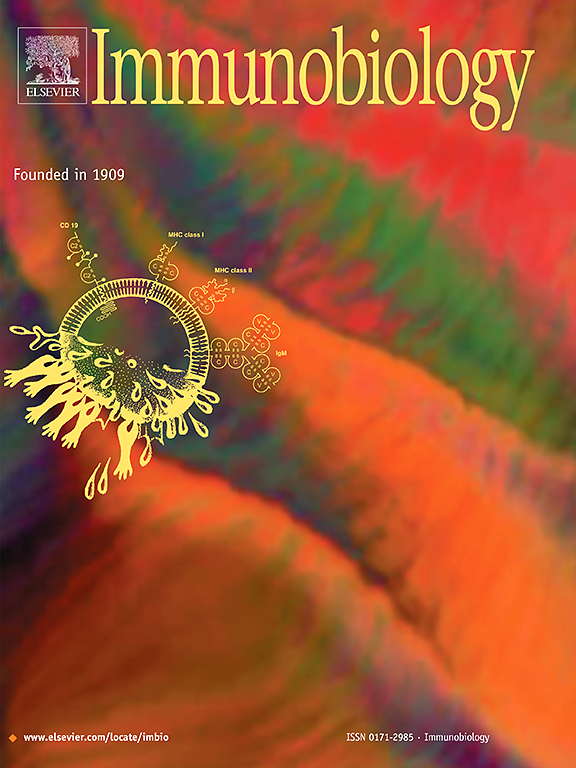朗汉斯巨细胞的免疫表型特征及CCR7在其形成中的作用
IF 2.3
4区 医学
Q3 IMMUNOLOGY
引用次数: 0
摘要
朗汉斯巨细胞(Langhans巨细胞)在肉芽肿疾病中起着至关重要的作用,但其独特的分子特征和形成机制尚不清楚。在本研究中,我们旨在系统地表征LGCs的分子特征,并揭示CCR7在其形成中的作用。小鼠骨髓源性巨噬细胞(bmmdms)被诱导和过滤以获得纯化的体外LGCs。RNA测序和生物信息学分析发现,lgc和M0巨噬细胞之间存在3000多个差异表达基因(DEGs),其中细胞因子介导的信号、细胞外基质和细胞因子受体活性显著富集。免疫表型分析显示抗原呈递分子(CD80, CD86, CD40)在LGCs中的表达升高,特别是在海洋分枝杆菌感染后。进一步的研究表明,与M0巨噬细胞相比,lgc中CCR7及其配体CCL19在RNA和蛋白质水平上的表达均显著上调。靶向CCR7的小干扰RNA (siRNA)导致LGC形成显著减少。免疫组织化学证实CCR7在肉芽肿模型小鼠和分枝杆菌感染患者的LGCs中表达升高。总之,与M0巨噬细胞相比,lgc具有明显的分子特征,抗原呈递分子表达升高,CCR7参与其中。CCR7在LGC的形成中起着至关重要的作用,为肉芽肿疾病的发病机制和潜在的治疗靶点提供了新的见解。本文章由计算机程序翻译,如有差异,请以英文原文为准。
Immunophenotypic characteristics of Langhans giant cells and the role of CCR7 in their formation
Langhans giant cells (LGCs) play a crucial role in granulomatous diseases, yet their unique molecular characteristics and formation mechanisms remain unclear. In this study, we aimed to systematically characterize the molecular features of LGCs and reveal the role of CCR7 in their formation. Mouse bone marrow-derived macrophages (BMDMs) were induced and filtrated to obtain purified LGCs in vitro. RNA sequencing and bioinformatics analysis identified over 3000 differentially expressed genes (DEGs) between LGCs and M0 macrophages, with significant enrichment in cytokine-mediated signaling, extracellular matrix, and cytokine receptor activity. Immunophenotypic analysis revealed elevated expression of antigen-presenting molecules (CD80, CD86, CD40) in LGCs, particularly after Mycobacterium marinum infection. Further investigations demonstrated that CCR7 expression, along with its ligand CCL19, was significantly upregulated at both RNA and protein levels in LGCs compared to M0 macrophages. Small interfering RNA (siRNA) targeting CCR7 led to a marked reduction in LGC formation. Immunohistochemistry confirmed elevated CCR7 expression in LGCs from granuloma model mice and patients with mycobacterial infections. In conclusion, LGCs exhibit distinct molecular characteristics compared to M0 macrophages, with elevated antigen-presenting molecule expression and CCR7 involvement. CCR7 plays a crucial role in LGC formation, providing novel insights into granulomatous disease pathogenesis and potential therapeutic targets.
求助全文
通过发布文献求助,成功后即可免费获取论文全文。
去求助
来源期刊

Immunobiology
医学-免疫学
CiteScore
5.00
自引率
3.60%
发文量
108
审稿时长
55 days
期刊介绍:
Immunobiology is a peer-reviewed journal that publishes highly innovative research approaches for a wide range of immunological subjects, including
• Innate Immunity,
• Adaptive Immunity,
• Complement Biology,
• Macrophage and Dendritic Cell Biology,
• Parasite Immunology,
• Tumour Immunology,
• Clinical Immunology,
• Immunogenetics,
• Immunotherapy and
• Immunopathology of infectious, allergic and autoimmune disease.
 求助内容:
求助内容: 应助结果提醒方式:
应助结果提醒方式:


